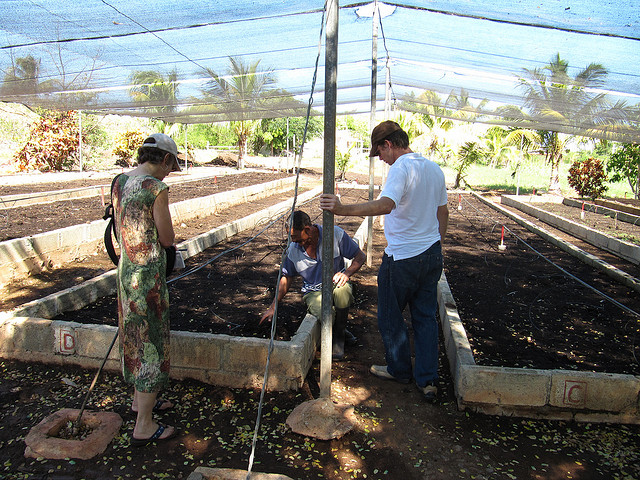As the world’s population becomes more urban, the natural resource base we depend on is increasingly becoming more depleted.
At the same time the continued failure to produce and distribute food in an environmentally sustainable and socially just way is growing harder to ignore—especially with the plight of hunger being a fact of life for so many in both Canada and the United States.
Thus it’s interesting to contemplate how, out of necessity, Cuba has emerged as a world leader in sustainable, urban agriculture by shifting its policies and practices to local, organic food production and self-sufficiency and away from its former export crops, such as sugar.
Until visiting Cuba, I like many Canadians, merely knew of Cuba’s social achievements, which, after the Revolution of 1959 declared access to education and health care basic human rights and thus free.
But Cuba also declared access to food a basic human right.
When this third right became difficult to uphold following the collapse of its prime supporter, the Soviet Union in 1990, Cuba in crisis shifted toward self-sufficiency and local food production. Since that time urban agriculture rather than rural, industrial, large-scale agriculture has increased dramatically. And the former industrial model targeting export crops bit the dust.
Because urban agriculture recognizes the efficiency of the small scale farmer or modest, local gardener who controls the plot of land, patio, backyard, balcony or roof top and the products of his or her labor, such gardens began to spring up everywhere.
This food has been consumed not only in the farmer’s households, but has also been donated to friends and neighbors, and sold in a variety of outlets throughout the city.
And this has spread to community plots on public land and to cooperative gardens, some supplying workers’ cafeterias, others like the state-run “organoponicos” providing fresh food for the urban and suburban populations of Havana where two million of Cuba’s 12 million people live.
New reforms under Raul Castro, who took power in 2008, have revitalized this movement by allocating under-used and idle lands to aspiring and existing farmers who wish to grow vegetables, fruit, grain, and fiber—like cotton or sisal—all for local use. Although this does not mean a severing with the global market, it does demonstrate a political and agrarian shift toward maximizing the use of local resources to meet local needs. It also represents an example of “food sovereignty,” which emphasizes the rights of men and women farmers to farm sustainably.
Sustainability is emerging everywhere in the world as a grass-roots movement in response to the decline in natural resources like clean water, arable land and fertile soil due to the intensive use of these resources by large-scale, industrial farming and its reliance on carbon-fueled machinery and petro-based chemicals.
But amazingly, Cuba presently stands out as a country that has achieved “first world” health status due not only to its combination of its free education and health care, but now also due to its sustainable and organic agricultural practices.
In fact urban, organic agriculture in Cuba has become so productive that farmers are voluntarily donating substantial amounts of nutritious fruits, vegetables, and medicinal plants like aloe to local community schools, daycare centers, and hospitals. The remainder is sold at markets and roadside stands.
Visiting Havana I saw small plots, patio container gardens, rooftop gardens, and literally gardens everywhere.
Abandoned spaces in the city, which previously had been breeding grounds for garbage, disease, and rodents, are now verdant community gardens, providing supplemental employment opportunities for youth and retirees in particular.
This revitalization of vacant lots that were formerly eyesores has aesthetic, social, and health value—for these plots are not only beautiful, but are developing a feeling of inter-generational community where knowledge is exchanged along with hand tools. Thus a more healthy, sane, and mindful environment is being created right along with a more healthy, kind, and mindful way of life.
And, at least in Havana, participants in urban gardening now find it constitutes not only a fresh supply of food, but also more than 20 percent of their household income.
Those working these community lots called “parcelas” can also participate in voluntary neighborhood “Grupos de Horticultores” (Horticultural Groups) to share info and knowledge and to facilitate the distribution of seeds and tools. This further increases community spirit and the simple, shared enjoyment of watching living things flourish.
Within each neighborhood there is increased interdependence and exchange.
People feel good contributing to the broader community.
And farmers experience satisfaction and pride in their gardens, which has a therapeutic effect. This small scale urban farming is as stress reducing as it is livelihood enriching, and the farmers enjoy it as much as a leisure activity as a necessary labor. For retirees in particular, they find daily gardening good exercise and enjoy staying active.
Very little is wasted as everyone has been practicing “reuse, repair, and recycle” since 1959. So this has been applied easily to gardening tools. Remember, Cuba is the land where cars even older than those from the 1950s are still running! Furthermore, the gardens produce compost and organic fertilizer, which returns to the garden and can be sold to other gardeners.
Home gardens increase household nutrition because of their immediate access—there is no time for lettuce to wilt in shipping when shipping is unnecessary! All local, urban agriculture eliminates the need for both significant transport and storage of produce.
This is not to say that Cuba is utopia.
Of course there are problems. For example, Cuba is encumbered with two currencies: working Cubans earn salaries in Cuban pesos, which can be used to buy basic goods and services like unprocessed food and local transportation. (That local transportation is also inadequate; buses are always full and not frequent enough, so everyone hitchhikes!) The second currency, the Convertible Peso, introduced in 2004 to replace the US dollar, is essentially for tourists to buy consumer goods like prepared or packaged food, restaurant meals, clothing, toiletries, and household items—things considered expensive for Cuban citizens.
To purchase these goods and services Cubans must convert their Cuban pesos into Convertible pesos at a poor exchange rate. At the same time, basic food and household goods provided through Cuba’s rationing system are not sufficient to meet the individual and household needs of Cubans. All petroleum-based products are extremely expensive so Cubans tend to use natural, often homemade products or go without.
Thus urban gardening with its food, herbs and medical plants, along with the supplementary income it provides, fills much of this need.
Although the nuclear family still predominates in Cuba, there is great diversity in who may comprise a given household: single parents, multi-generational families, blended families, and multi-families sharing living arrangements are all common. But due to housing shortages, single person living arrangements are rare. Thus there is no shortage of labor to maintain a garden!
And Cuba enjoys a tropical climate with a yearly average temperature of 25°C, so vegetables can be grown all year. The only climatic interruption are the erratic autumn hurricanes that can damage or destroy fruit trees in their path.
The Cuban diet consists of basic, unprocessed food such as rice, beans, and root vegetables like potatoes and sweet potatoes. Tomato slices are frequently added to meals, and the meals are prepared from scratch. But the diet is fresh and varied. Because there is no jar of mayo, mayonnaise is made mixing eggs and oil, and because there is no blender, this is mixed by hand.
Often a small patio is the dining room, outdoor kitchen, as well as the garden in which might be found chard growing in a small plot, and fruit trees like guava, lemon, cherry, and banana crammed around the edges and thriving. Cubans who share a patio really seem to enjoy and take pride in their patio life.
Sometimes there are “free range” chickens underfoot, chickens that are egg-layers and roosters that provide the occasional dinner. These chickens are usually fed garden waste or cooked food scraps, because grains such as corn or dried peas are scarce.
Those fortunate to have a backyard can grow garden beds of squash, yucca, spinach, and parsley. It is also common to see avocado, orange and banana trees there. When compost from a yard is inadequate, organic solid manure from cattle farms can be bought in sacks made from used and recycled rice, flour or produce sacks sewn together by hand.
Although gardening is harder for people in apartment buildings, they find rooftop gardening also improves their quality of life. And almost every apartment in Cuba has a balcony where chives, tomatoes, garlic, herbs, and spices can be easily grown in containers.
There is much to be learned from the policies, actions and success of Cuban farmers and the Cuban administration.
Although I am by no means a Communist, I have witnessed that Cuba is a good model of efficient, small-scale and sustainable farming. Cuba has encouraged local communities to be more self-reliant rather than dependent on external markets (imports and exports).
In Canada and the United States the movement toward self-sufficiency and small-scale, local food production is largely a grass-roots movement in spite of unsupportive governments. International trade agreements and corporate control of food still dominates. Yet organic, local farming persists in the face of these dominant public policies. These farms resist the consolidation of the food chain, which puts ever more power and resources into the hands of a few transnational corporations like the chemical company Monsanto.
Contrary to the “efficiency” of such large-scale production driven by imports and exports and which focuses on quantity rather than on quality and variety, this corporate model fails to consider the limitations, waste and vulnerability of its process.
Small farms are better at retaining and recycling organic materials and use less mechanization. By planting diverse crops, the soil is preserved and sustainable production ensured. Crop diversity means less vulnerability to pests and better adaptability to changing seasons and climatic conditions.
As shipping costs rise, even corporate giants may begin to lose their competitive advantage in the global food market.
My personal hope is that research and advocacy must continue to move world governments toward a more people-centered, community supported farming and distribution. Such self-sufficiency means less reliance on fossil fuels. Cuba’s urban farming provides an example of the full spectrum of health—physical, mental, and environmental—from so doing.
Love elephant and want to go steady?
Sign up for our (curated) daily and weekly newsletters!
Editor: Catherine Monkman
Photos: tardigrade/Flickr, Stacey Spensley/Flickr, Justin V/Flickr
 Share on bsky
Share on bsky








Read 6 comments and reply